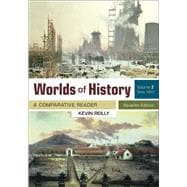Worlds of History offers a flexible comparative and thematic organization that accommodates a variety of teaching approaches and helps students to make cross-cultural comparisons. Thoughtfully compiled by a distinguished world historian and community college instructor, each chapter presents a wide array of primary and secondary sources arranged around a major theme — such as universal religions, the environment and technology, or gender and family — across two or more cultures, along with pedagogy that builds students’ capacity to analyze and interpret sources, and think critically and independently









